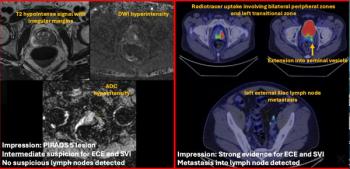Emerging research suggests that artificial intelligence (AI) may enhance the detection and localization of interval breast cancer on screening mammography.
In the retrospective study, recently published in Radiology, researchers assessed the use of a stand-alone AI system (Lunit Insight MMG, version 1.1.2.0, Lunit) in 2,052 women (median age of 57) who had screening mammography (including 514 cases of diagnosed invasive breast cancer). Women with dense breasts accounted for 81.3 percent of the cases involving interval breast cancer.
Employing a threshold 96 percent sensitivity rate, the researchers found that AI diagnosed 23.5 percent of interval breast cancer cases and provided correct localization in 76.9 percent of those cases. The study authors also pointed out significantly higher median AI scores for invasive tumors (62 vs. 33 for non-invasive tumors) and grade 2-3 tumors (62 vs. 45 for grade 0-1 tumors).
“ … A standalone artificial intelligence (AI) system improved early cancer detection on screening mammograms by correctly identifying some cancers that were missed by two human readers,” wrote lead study author Muzna Nanaa, M.D., who is affiliated with the Department of Radiology in the School of Clinical Medicine at the University of Cambridge in Cambridge, England, and colleagues.
The study authors also found that the AI platform provided higher rates of correct localization in interval cancers with minimal signs of malignancy (46 percent) and cases involving false-negative interval cancers (50 percent) in contrast to true-negative interval cancers (12.6 percent).
“Deep learning algorithms have the potential to detect ICs that are either mammographically occult or masked by breast density and thus beyond perception by the human eye,” noted Nanaa and colleagues.
Three Key Takeaways
1. Improved early detection: The AI system improved early breast cancer detection on screening mammograms by correctly identifying 23.5% of interval breast cancer cases, which were missed by two human readers, and provided correct localization in 76.9% of those cases.
2. Effective in dense breasts. The AI system demonstrated significant efficacy in identifying and localizing interval cancers (ICs) in women with dense breasts, which are often challenging to detect using traditional methods.
3. Localization challenges with triple-negative cancers. While the AI system showed promise in localizing certain types of invasive and node-positive cancers, it was less effective in localizing triple-negative cancers, with a significant portion of these cases not flagged by the AI.
While the AI system provided correct localization for 19.7 percent of luminal cancers and 24.2 percent of node-positive cancers, the researchers found the AI system was not as effective at localizing triple-negative cancers (8.1 percent).
“The remaining triple-negative cancers were not flagged by the AI algorithm at any threshold (25 of 49), had AI scores lower than the threshold (17 of 49), or were incorrectly localized by the AI algorithm (three of 49),” added Nanaa and colleagues.
(Editor’s note: For related content, see “Can AI Facilitate Effective Triage for Supplemental Breast MRI After Negative Mammography Screening?,” “Mammography Study Shows Supplemental Ultrasound Has Higher Sensitivity than Adjunctive AI in Dense Breasts” and “Can Multimodal AI Enhance Prediction of Axillary Lymph Node Metastasis Beyond MRI or Ultrasound-Based Models?”)
Beyond the inherent limitations of a retrospective study design, the authors acknowledged a small sample size of false negative cases and noted that evaluation of one AI platform limits extrapolation of the study findings to the use of other AI systems for mammography interpretation.





























